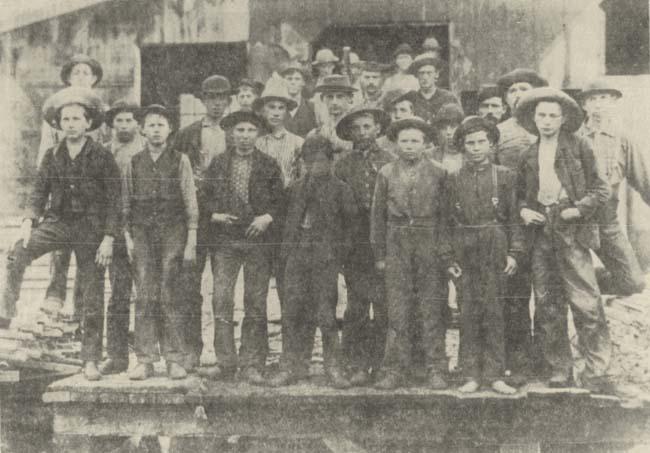![]()
Lansing Lath Mill

| Long Days, Short Pay - These youngsters of 14 to 16 years worked 12 hours a day, six days a week at 60 cents a day in a Lansing, Iowa, lath mill. Julius T. Roggensack of La Crosse, who owns the old photo, was employed by the mill as a delivery boy, and he earned the princely pay of 75 cents per day. Roggensack is still unwilling to concede that life in this day and age is much of an improvement over the “good old days.” The boys in the picture were not identified. |
Local Man Used To Work 12-Hour Day at
Lansing For 60-75 Cents. Still Prefers ‘Good Old Days’
By Joseph K. Kidder, La Crosse Tribune
Memories of the Lansing, Iowa, lath mill of nearly three-quarters of a century ago and the days when boys from 14 to 16 years of age earned 60 cents for a 12-hour day of hard work are revived by a picture owned by a La Crosse man. It is the property of Julius T. Roggensack, 86, of 1802 Loomis St. He does not appear in the picture himself, having been promoted to the better job of delivering, with a horse and wagon, “trimmin’s” and waste pieces that were sold to villagers for fuel. His pay was in the “upper brackets,” 75 cents for the 12-hour day.
“If there is anything deserving of a niche in whatever hall of fame Lansing may have,” days Roggensack, “it is the whistle of that mill, which was owned by a Mr. Robinson. For years it woke up Lansing and the surrounding countryside every morning of every day except Sunday at 5 a.m. It blew continuously for five minutes to insure that the mill workers would be on the job at 6 a.m.”
Roggensack came to La Crosse in the 1890’s and became a carriage painter, under the tutelage of Jeff Gibbons, foreman at the Wallis Carriage Co., at Third and Badger street. He moved to Rochester and for 35 years painted every automobile owned by the Drs. Will and Charlie Mayo, founders of the Mayo Clinic. He recalls that in 1905 there were but six autos in Rochester, of which the Mayo’s owned two.
For several years he was engaged in experimental work for Conservation Commissions and operated a farm eight miles east of Rochester, where various plants and grains were introduced and developed. Roggensack has survived both his wife and daughter.
It has been 72 years since Roggensack, as a boy, worked 12 hours a day for 60 cents a day, but he is still unwilling to concede that present day life is much of an improvement. “In those days,” Roggensack reminisces, “we had something that was invaluable. It was a great degree of personal liberty. The statues were not cluttered with restrictions on our daily activities. We could come and go and do pretty much as we pleased. Of course some restrictions became necessary, such as the shooting of game. But it was not the custom when someone developed a pasttime he really enjoyed, to run to state capitals and pass a law against it. Yep, the good old days were really good.”~La Crosse Tribune, January 14, 1964
~transcribed by Aubrie Monroe for Allamakee co. IAGenWeb
~*~*~